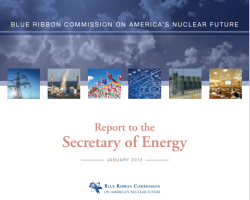Category of Content
Siting Experience Documents Only
Publication Date
Subject Matter
Keywords
Criticality Consequence Analysis Involving Intact PWR SNF in a Degraded 21 PWR Assembly Waste Package
Criticality Consequence Analysis Involving Intact PWR SNF in a Degraded 21 PWR Assembly Waste Package
Intact and Degraded Mode Criticality Calculations for the Codisposal of ATR Spent Nuclear Fuel in a Waste Package
Intact and Degraded Mode Criticality Calculations for the Codisposal of ATR Spent Nuclear Fuel in a Waste Package
Letter to President Obama - Blue Ribbon Commission
Letter to President Obama - Blue Ribbon Commission
Dear Mr. President:
At your direction, the Secretary of Energy established the Blue Ribbon Commission on
America’s Nuclear Future to review policies for managing the back end of the nuclear
fuel cycle and recommend a new strategy. We are pleased to be serving as Co‐
Chairmen of the Commission, and we are writing to you to highlight an important action
we strongly believe should be reflected in your Fiscal Year 2013 baseline budget
projections.
In our draft report to the Secretary, issued in July of this year, the Commission
Recommendation by the Secretary of Energy of Candidate Sites for Site Characterization for the First Radioactive-Waste Repository
Recommendation by the Secretary of Energy of Candidate Sites for Site Characterization for the First Radioactive-Waste Repository
The Nuclear Waste Policy Act of 1982 (the Act), established a
step-by-step process for the siting of the nation's first repository for
high-level radioactive waste and spent fuel. The Act gave the Department of
Energy (DOE) the primary responsibility for conducting this siting process.
The first step in the process laid out in the Act was the development by
the DOE, with the concurrence of the Nuclear Regulatory Commission (NRC), of
general guidelines to be used by the Secretary of the DOE (the Secretary) in
Technical Bases for Extended Dry Storage of Spent Nuclear Fuel
Technical Bases for Extended Dry Storage of Spent Nuclear Fuel
Independent spent fuel storage installations (ISFSIs) are currently licensed for 20 years. However, delays in developing permanent spent fuel disposal capability require continued ISFSI storage beyond the 20-year term. This report provides a technical basis for demonstrating the feasibility of extended spent fuel storage in ISFSIs.
EBS Radionuclide Transport Abstraction
EBS Radionuclide Transport Abstraction
The purpose of this report is to develop and analyze the Engineered Barrier System (EBS) Radionuclide Transport Abstraction Model, consistent with Level I and Level II model validation, as identified in Technical Work Plan for: Near-Field Environment: Engineered Barrier System: Radionuclide Transport Abstraction Model Report (BSC 2006 [DIRS 177739]). The EBS Radionuclide Transport Abstraction (or RTA) is the conceptual model used in the Total System Performance Assessment (TSPA) to determine the rate of radionuclide releases from the EBS to the unsaturated zone (UZ).
Blue Ribbon Commission on America’s Nuclear Future Draft Report to the Secretary of Energy
Blue Ribbon Commission on America’s Nuclear Future Draft Report to the Secretary of Energy
America’s nuclear waste management program is at an impasse. The Obama Administration’s decision
to halt work on a repository at Yucca Mountain in Nevada is but the latest indicator of a policy that has
been troubled for decades and has now all but completely broken down. The approach laid out under
the 1987 Amendments to the Nuclear Waste Policy Act (NWPA)—which tied the entire U.S. high-level
waste management program to the fate of the Yucca Mountain site—has not worked to produce a
Blue Ribbon Commission on America’s Nuclear Future Report to the Secretary of Energy
Blue Ribbon Commission on America’s Nuclear Future Report to the Secretary of Energy
This report highlights the findings and conclusions of the Blue Ribbon Commission on America’s Nuclear Future (BRC) and presents recommendations for consideration by the Administration and Congress, as well as interested state, tribal and local governments, other stakeholders, and the public.

